In this article:
A newborn baby is growing fast and needs proper nutrition enriched with useful trace elements. Up to 4 months, breast milk is enough for good nutrition, which contains all the vitamins and trace elements necessary for the growth and strengthening of the baby's immunity. If there is not enough milk, the pediatrician will recommend formula. It is impossible to feed juices and fruit purees in the first months of a baby's life.
Why can't fruit puree be given to a child before 4 months?
Let's look at the main reasons why complementary foods are introduced after four months of age:
- The child was fed through the umbilical cord during 9 months of intrauterine life. All this time, the baby's gastrointestinal tract did not work at full strength. After the birth, the baby will have a difficult adaptation not only in the outside world, but also in the new nutrition system. At breastfeeding the newborn is often tormented painful colic, indicating the accumulation of gases, and what will happen if you give the child fruit puree even hard to imagine.
- Up to 4 months digestive system the baby is accustomed to digest milk. Accordingly, the child's body is not able to digest solid food. Fruit puree has a viscous consistency, so there can be serious digestion problems.
- Fruit contains acid, which can become an irritant of the gastrointestinal tract and cause severe dysbacteriosis in a baby or diarrhea, leading to dehydration.
- Fruit feeding in early age can cause allergic reactions, which can worsen in the future and lead to serious health problems.
What fruits to prepare baby puree from?
At the age of 4 months, you can diversify the child's diet with fruit puree. It is necessary to choose fruits that are less allergenic and easier to digest:
- Apples of green varieties (red and yellow can cause diathesis);
- Pears;
- Bananas.
The rest of the assortment of fruits should be left for later and introduced into the diet when the child grows up.
How to cook applesauce?
Take an apple of green varieties, always a fresh crop grown in Russia, because for long-term storage, apples are treated with special substances that may contain harmful trace elements.
Wash the fruit under running water, you can even use laundry soap to get rid of pathogenic bacteria for sure. Peel the apple from the peel, remove the seeds, cut into small cubes. Take a clean enameled pan, pour chopped apples into it, pour in a little water (about 2 tablespoons) and simmer for 4-5 minutes. Whisk applesauce with a mixer or blender, or rub through a strainer to remove lumps that the baby can choke on. Serve this dish warm.
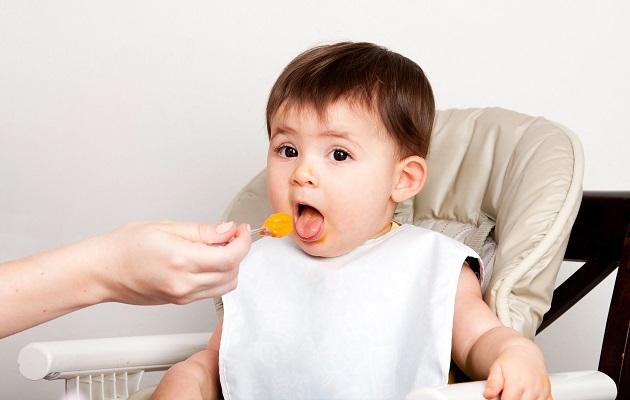
In a similar way, mashed potatoes for babies from other fruits are prepared. You can try making a puree with several ingredients, such as mixing an apple, banana, and pear.
Sugar should not be added during the preparation of fruit puree. The child will be happy to eat a new dish without flavor enhancers, which do not contain useful trace elements, but on the contrary can harm the child's body.
Rules for feeding with fruit puree for a baby:
- Introduce fruit puree into your diet gradually. You need to start with 1 teaspoon, then slowly increase the amount so as not to harm the child's digestion.
- Give fruit puree in the morning before meals, so as not to cause fermentation.
- After serving a new dish, follow the reaction of the body. If redness appears on the cheeks and buttocks, this is diathesis, which indicates that New Product body did not accept. In this case, you should exclude this ingredient for a while and try another fruit.
- Pay attention to the child's stool, if mucus or green feces appear in it, then the new dish is poorly absorbed by the baby's body. You need to reduce the number of servings or delay with complementary foods.
Should I give my child mashed fruit bought at the store?
On the shelves of modern stores you can find a wide range of products with baby food different kind, which are analogues of food prepared by oneself:
- mixtures;
- Kashi;
- vegetable puree;
- fruit purees;
- Meat puree;
- Baby juices.
It is possible to introduce fruit puree from a jar into the child's diet, but carefully. At the time of buying baby food it is necessary to carefully read the content of the product and the release date so as not to purchase an unsuitable product for food. You need to choose fruit puree without preservatives and flavor enhancers. Carefully look at the condition of the packaging, it should be free of damage and swelling, which indicate the poor quality of the contents.
Ready-made food for babies significantly reduces the time for cooking, gives the mother the opportunity to set aside time for rest, instead of daily cooking for the baby.
Useful food video
The best dietary product is an apple. It is essential for healthy growth and development of the baby. They want to introduce it into the diet as early as possible, but certain rules must be observed. If this is not done, you can cause the child to be allergic to apples. From how many months can you give this fruit to a child so that it is only for the benefit of his body? Let's take a look FAQ on apple food and acceptable recipes for children from apples.
The Ministry of Health advises introducing complementary foods for newborns from the 6th month of life. But sometimes mothers fail to do this for various reasons: the child's allergies to complementary foods, colic, the unpreparedness of the mother herself. You should not worry and be scared, you can just wait and introduce new food for the baby from 7 months. There is nothing wrong with this later feeding.
To introduce complementary foods, you need to get a personal plate, cup, spoon for the baby, as well as cleaning products for baby dishes. The whole set is better to buy in duplicate. Don't forget bibs. A separate kit is bought to comply with children's hygiene, so that you do not mix up and wash children's dishes with ordinary chemicals. If your child is not sitting, then you can feed him in a special children's "reclining" chair or in a deck chair.
The first plant foods for your baby should be vegetables and fruits that grow in your lane. Therefore, apples can be entered without fear. Some mothers start complementary foods with them, babies like them more because of the sweet taste, but it is still advisable to first introduce a couple of vegetables and only then apples. First, it is better to add them in the form of a puree. Then you can give a finely chopped or grated apple. If the baby has teeth and a desire to chew, then give them in small pieces.
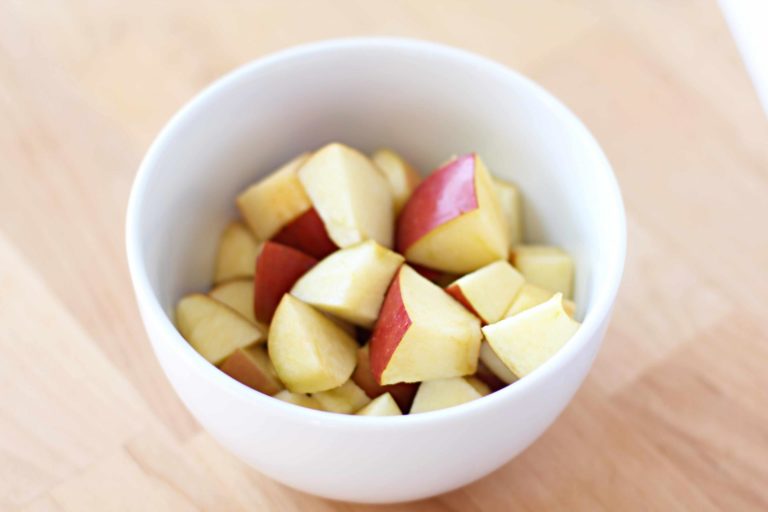 Make sure you chew every bite!
Make sure you chew every bite! Tips from Komarovsky:
- introduce green apples first, they are more useful, allergies to them are less common;
- having bought an apple, first cut it and leave it in the open air. A fruit rich in iron will quickly oxidize, while a fruit stuffed with chemicals is preserved for a long time and does not deteriorate;
- give preference to homemade puree, rather than store-bought canned food, or buy specialized baby food.
Juices, compotes, purees
Ambiguous opinion among pediatricians and mothers on the introduction of apple juice. Some say that it is better to start with it, while others are strongly opposed. The reason for the different attitudes is not in the juice itself, but in preservatives: the juice containing them is not suitable for feeding a child. Do not give juices containing emulsifiers, dyes, sweeteners and additives with the E index. Real baby juice should consist of two components: water and an apple.
Such juice is preferable to puree due to its lower concentration. But finding such natural juices can be problematic. In any case, making juice or compote yourself from fresh apples is not so difficult. If you haven’t found natural juice, but don’t want to cook yourself, then it’s better to start with the introduction of mashed potatoes.
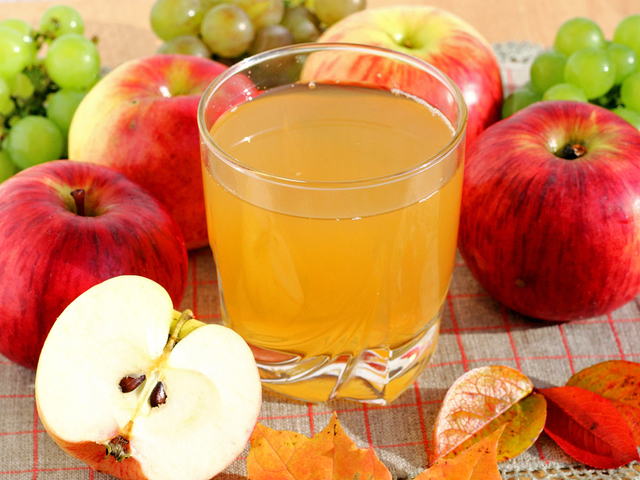 Juicer - a great helper in the kitchen of a young mother
Juicer - a great helper in the kitchen of a young mother After adding puree, you can try to give small pieces of apples the size of a fingernail. Whole fruit can be given to your baby if he is teething and trying to chew. If the baby refuses raw apples, then try giving him baked ones. Also give preference to baked apples if your baby has flatulence when feeding fresh. They have a mild laxative effect and relieve babies from constipation.
Puree mixes with vegetables
Puree mixtures can be introduced only if both products have already been introduced into the baby's complementary foods. In other words, both products are introduced separately at first. For example, you fed your baby applesauce in the morning, and gave a spoonful of carrot puree in the evening. After the carrot puree is introduced, you can make an apple-carrot mixture. But this rule is not so important. Many mothers, when adding a new product, immediately mix it with those already introduced, and no problems arise.
 It happens that they start complementary foods with apple-pumpkin puree, and then they introduce pure apple
It happens that they start complementary foods with apple-pumpkin puree, and then they introduce pure apple Common mixtures are mashed apples and carrots, cabbage, pumpkin. It should be noted that the first mixtures should again consist of fruits and vegetables from your natural area. For example, it is better to leave apple-banana purees for a later time, and it is advisable to start with pumpkin, cabbage, pears and other “native” products.
Other nuances of the introduction
Can you be allergic to green apples?
There is an allergy to apples with a hereditary predisposition, so if there is an allergy in the family, then the child should be introduced after other products and carefully. Green apples are less allergenic than red ones. However, even they can be allergic. If there are no allergies in the family, and the child has signs of it after, then perhaps the body did not react to the apples themselves: preservatives and nitrates could be the cause of the allergy.
To reduce the risk of allergies, follow these tips:
- buy apples growing in your lane;
- peel them, it contains the largest amount of preservatives;
- increase their content in complementary foods gradually;
- introduce fruits into complementary foods no earlier than 5-6 months;
- give preference to green varieties.
 green apples the least allergenic for the baby
green apples the least allergenic for the baby Common allergy symptoms are itching, redness, flatulence, diarrhea or vomiting. Often the cause of allergies is the early addition of the product to the diet. If the child has warning signs, then remove them from complementary foods and re-enter after a month. If you added apples to your diet first, then after an allergic reaction, remove them and introduce vegetables first.
Can I use it for diarrhea
Not possible, but necessary. The pectin contained in them strengthens the baby's stool. Just don't give them fresh. Apples are rough vegetable food. With increased intestinal activity, they do not have time to be absorbed properly. Therefore, make mashed potatoes or jelly out of them. Other products also help very well - rice and other cereals, bananas (if already introduced).
A 2-year-old child asks for an apple at night
If a child eats an apple before going to bed, then this is completely normal. Children lead an active lifestyle and grow very quickly, so they need a lot of energy and "building materials" for the body. The apple is one of the most useful products. For normal sleep, the child must be full. Given all this, we can conclude that eating an apple before bedtime is the best habit for a child. Remember that this behavior is common and is considered normal.
 It happens that a nightly request for an apple or other fruit is not a signal of crumb hunger. He needs attention from his parents.
It happens that a nightly request for an apple or other fruit is not a signal of crumb hunger. He needs attention from his parents. Another situation is if a child aged 2 years old wakes up at night and requires food. The cause of night hunger may be the natural need of the body. If the child does not gain weight from such night feeding (and it is difficult to gain weight with this fruit), then let him eat. Another thing is if the cause is habit or the need for attention from parents. In this case, it is important for the child to fulfill his request, but there is no need for food itself. Then the child eats a little, 2-3 tablespoons of puree, for example.
To get rid of the habit, use one of the following methods:
- show the child where and what lies and let him take the apples himself;
- tell him what to cook now, and let him lie and wait for you to return, most likely, the child will already fall asleep;
- feed him more solidly before bed or give him more high-calorie food (meat);
- it may be that the child simply does not calm down enough in the evening. Then you need to bathe him before going to bed, it relieves stress well.
The child eats a lot of apples
According to nutritionists, it is impossible to eat too many apples. If there is no bowel disorder, then let him eat. This is one of the most useful and dietary foods, so children and adults can eat them in any quantity. Another thing is that, perhaps, the child's body lacks iron. Then try to buy apples that contain more iron. They can be determined by the rate of oxidation in air.
 Entertaining mothers know how to attract the baby to the table
Entertaining mothers know how to attract the baby to the table Why raw food is not digested
Sometimes it happens that undigested pieces of apples appear in the stool. If the child eats them in large quantities, then this is within the normal range. It happens that such a phenomenon is only one of the symptoms, for example, the stool is not formed with other products, and the child does not gain weight. But if there are no other symptoms, and pieces are found even after 1-2 apples, then you should go to a pediatric gastroenterologist.
The most common cause of this symptom is an enzyme deficiency. The enzymes responsible for their digestion are not produced in the right quantities. There is nothing wrong with this, but if a diagnosis is made, then apples will have to be abandoned. They can be exchanged for pears and other fruits.
Recipes for the little ones
Apple juice
Pre-remove the seeds and the hard "box" in which they are located. Pass through a juicer, you can with the peel. After that, the resulting mixture is filtered through a clean gauze. If the strained juice is sour, then add sugar to taste. Such juice can be drunk immediately, but it is not stored for more than a day. At first, pure juice should not be given to children, it must first be diluted in water in a ratio of 1: 1.
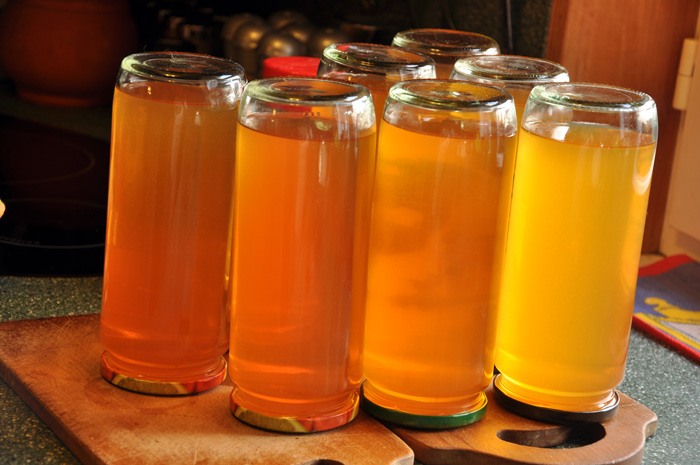 Usually, jars are turned upside down after canning for two reasons: tradition (as my mother and grandmother taught) and checking the tightness of the spin
Usually, jars are turned upside down after canning for two reasons: tradition (as my mother and grandmother taught) and checking the tightness of the spin To store the juice, you need to sterilize it and roll it up for storage in jars. To do this, bring the juice to a boil over low heat. Remove the appeared foam, it is necessary to boil until the foam ceases to stand out. In order not to introduce microorganisms into the product or to prevent the glass from cracking, hot juice is poured into jars heated in the oven. After that, they are closed with tin lids using a seaming machine. Then they are wrapped in towels and stored like that until they cool down.
How to make compote
Cut the apples into slices, 3-4 fruits are enough for a medium-sized saucepan. Put the cut into a saucepan and cover with water. Put on a slow fire and bring to a boil. When boiling, constantly remove the resulting foam. The softness of the chopped slices will tell you about readiness. Let the pan cool slightly and add sugar to taste if necessary.
A decoction of dried
You can enter such a drink from the age of 6 months of crumbs. For the first time, it will be enough to take 20 grams of dried apples, rinse them well and, just in case, inspect for quality (no mold, blackening, signs of rotting). After this, dried fruits are steamed with a small amount of boiled water, and the “semi-finished product” is left for 20 minutes to infuse. Separately heat a glass of water to 80°C. Steamed apples are laid out in a thermos and prepared hot water. After a couple of hours, the broth is cooled and given to the baby. You need to start with one teaspoon.
 If the baby really asks you for dried apples, before that, you must first pour boiling water over the dried fruits
If the baby really asks you for dried apples, before that, you must first pour boiling water over the dried fruits Boiled apple: simplicity and benefits
Take a small saucepan. Cut the fruits into rings and lay on the bottom, before that, clean them from hard inner films and seeds. Top with water so that it covers the rings for one finger. Boil for 10 minutes, remove the resulting foam. The resulting juice can be drunk, just strain it first through cheesecloth and add sugar. Make mashed apples from boiled apples or give them whole.
Baked in the microwave
Made with a microwave. Cut the apples in half and remove the core. You can peel them from the top and sprinkle with sugar. Keep on normal mode in the microwave for 3-5 minutes. Ready fruits are soft like puree.
 Curious and beautiful dish it turns out that if you add dried apricots and raisins to the core of an apple, however, do not forget that such food is not supposed to be given to the baby before a year, and preferably one and a half
Curious and beautiful dish it turns out that if you add dried apricots and raisins to the core of an apple, however, do not forget that such food is not supposed to be given to the baby before a year, and preferably one and a half An apple is the safest fruit for babies. It contains a lot of vitamins and useful elements, including B vitamins and ascorbic acid, iron and phosphorus, calcium and potassium, vegetable fiber. It is an excellent source of energy and strength. Apples strengthen the immune system, have a positive effect on blood composition and circulation, improve digestion and help with constipation.
Apples rarely cause allergies, so they are considered the safest fruit for infants. Pediatricians advise including this product in the diet after vegetables for the seventh month. Complementary foods with an apple start with mashed potatoes. In the first months, fruits should be given only after heat treatment, as fresh fruits cause indigestion and stool disorders, indigestion and other similar problems. In this article, we will take a closer look at how to introduce an apple into complementary foods.
Useful properties of apples
- Fill the body with energy, restore strength and energize;
- Strengthen immunity;
- Stimulate brain activity and improve the functioning of nerve cells, soothe and relieve stress;
- Increase appetite and improve metabolism;
- Cleanse the body and relieve swelling, remove harmful substances and excess fluid;
- They improve the work of digestion and eliminate constipation in infants;
- Normalize hematopoiesis, prevent the appearance and development of anemia;
- Improve the condition of the skin and gums, hair and nails;
- Regulate blood pressure, prevent diseases of the heart and blood vessels;
- Participate in the formation bone tissue and promote muscle growth.

How to introduce an apple into the baby's diet
Complementary foods with applesauce begin in the seventh month of a child's life after the introduction of most of the vegetables, including cauliflower and broccoli, zucchini and potatoes, carrots. Such products are easier to digest and digest, safer. A more detailed table of introducing complementary foods for babies is presented.
For the first time, the crumbs are given half a teaspoon of the finished dish in the morning. Observe the reaction of the baby for two days. If the child feels well, you can give apples further and gradually increase the portion of puree. The norm of introduced applesauce at 7-8 months is 60-80 grams. For a child per year, it increases to 100-120 grams.
Curd apple dessert
- Cottage cheese - 50 grams;
- Apples - ½ piece;
- Pumpkin - 30 grams of pulp.

Prepare pumpkin pulp, remove seeds and chop. Pour in water and cook until soft. Peel the apples and cut into slices, add to the pumpkin. Boil the ingredients for another 3-4 minutes and, after cooking, grind in a blender, mix with cottage cheese. Optionally, you can add a teaspoon of sour cream. Such a dessert is perfect for a baby at 10-11 months.
Cottage cheese casserole with an apple for children a year
- Cottage cheese - 0.5 kg;
- Apple - 2 pieces;
- Semolina - 2 tables. spoons;
- Raisins - 40 grams;
- Chicken egg - 1 piece;
- Sugar - 2 tables. spoons;
- Sour cream - 3 tables. spoons.
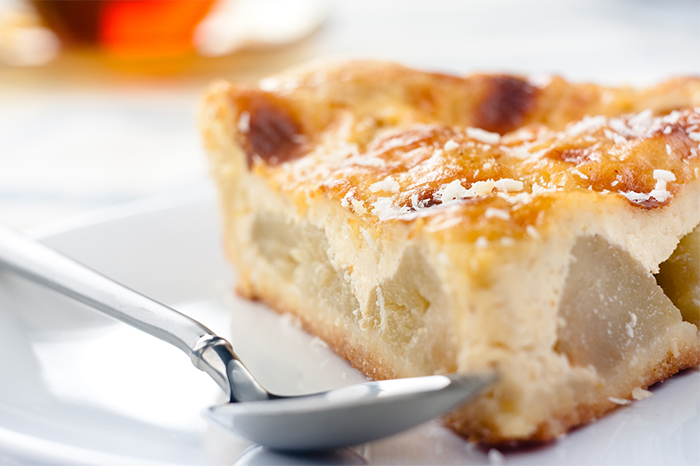
Mix cottage cheese with sour cream, break an egg and add to cottage cheese, mix again. Beat the resulting mass with a blender or whisk, add semolina and mix. Peel the apples, cut into small pieces and, together with the washed raisins, add to the curd mixture. Pour in sugar and mix. Put the mass in a baking dish and cook in the oven for forty minutes at 180 degrees. Instead of raisins, you can add chopped dried apricots or prunes.
Corn porridge for babies 1.5 years
- Corn grits - 100 gr;
- Apple - 1 piece;
- Pumpkin - 100 gr of pulp.
Pour grits cold water in a volume of 300 ml and cook until tender. Peel the pumpkin pulp from the seeds and cut into pieces, peel and cut the apples as well. Put the ingredients in a pan with a little water and bake for 20 minutes in the oven at 160-180 degrees. Or a pumpkin and an apple can be steamed. Ready ingredients are added to the porridge, sugar is added if desired. In the same way, you can cook rice or oatmeal.
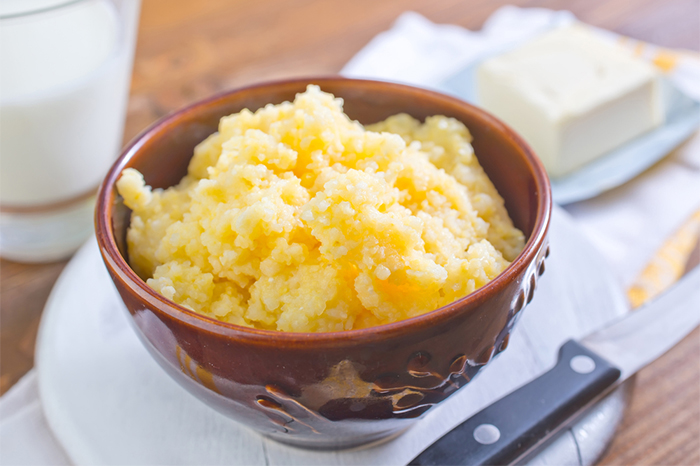
Salads with apple
An apple goes well with beets or carrots. Such dishes can be given to a baby after a year. To prepare carrot and apple salad, peel carrots and apple, grate and mix. Season the dish with a teaspoon of honey. Sprinkle the top of the salad with sesame seeds.
To prepare beetroot salad with apple, pre-cook the beetroot. Peel and grate the ingredients, mix and season with a teaspoon of low-fat sour cream. For babies over 1.5 years old, 30 grams of chopped walnuts and 50 grams of raisins can be added to the recipe. Nuts and raisins are mixed with grated boiled beets and grated apple, seasoned with vegetable oil. Many interesting salad recipes for the little ones are presented.
Which canned applesauce to choose
You don't have to make your own baby food puree. Of course, homemade food is healthier and safer, but the finished product is much more convenient. In addition, the composition of baby food is optimally balanced and adapted to the age and needs of the crumbs. It is important to choose a quality reliable product that the baby will like. We offer an overview of the most popular brands baby puree for feeding.
| Brand | Characteristic | Price |
| FrutoNanny | Hypoallergenic safe product free of starch and salt, includes a wide range of purees with single and multi-component composition, convenient sealed packaging, sweet and pleasant taste, kids like it | 30 rubles (100 gr) |
| Semper | 100% natural composition with apple and vitamin C without starch, flour and sugar, does not cause allergies, offers a wide range of products and flavors | 75 rubles (125 gr) |
| Babushkino Lukoshko | Safe and affordable food, does not contain starch, salt and sugar, however, some products contain milk instead of water, which is not recommended for children under one year old due to the allergenicity of cow protein | 30 rubles (100 gr) |
| Gardens of the Don | The cheapest and most affordable food, a safe composition without milk and sugar, but sometimes it causes allergies, kids often don’t like the taste, not very convenient and not sealed packaging | 15 rubles (125 gr) |
| hipp | Safe, high-quality and environmentally friendly complementary foods, rarely causes allergies and improves appetite, improves digestion and stool, but the bland taste of some purees may not appeal to the baby | 50 rubles (80 gr)) |
| Gerber | Eco-friendly and safe product, has a positive effect on the health and growth of teeth, the formation of the bone skeleton, a wide range of single- and multi-component purees | 40 rubles (80 gr) |
| Nutricia | A balanced and safe composition containing pectin and dietary fiber without sugar, but with a starch content, which can adversely affect digestion | 40 rubles (125 gr) |
| Heinz | Delicious and varied baby food, high-quality and safe composition without starch, contains prebiotics, which normalizes digestion | 50 rubles (100 gr) |
Regardless of which brand you choose, remember that every baby is different and perceives the product differently. One child may really like mashed potatoes, while another may be allergic to the same product. AT this case You'll have to change brands until you find the right one. Before choosing, be sure to check the integrity of the package, it is advisable to choose a sealed container.
Before buying, study the expiration date and composition of the puree. Food should not contain preservatives, dyes and other chemicals. For children under one year old, it should be without sugar, salt, milk and starch. It is good if the product contains pro- and prebiotics, vitamins and other beneficial substances. Do not forget that the product must be appropriate for the age of the baby!
Pediatricians have different views on the timing of the introduction of complementary foods. Much depends on the individual characteristics of the baby. To date, the age of 6 months is considered optimal for children who eat breast milk. Babies whose main type of nutrition is milk formulas can be introduced complementary foods 1 or 1.5 months earlier.
In order for the acquaintance of the crumbs with an apple to be successful, you need to choose sweet and sour green apples. Why green? Because they rarely provoke allergic reactions. Green apples are the richest in pectin, which has a beneficial effect on digestion. The presence of this component will help the baby to more easily learn a new product.
So, the child has already tried apple juice and got good impressions from its taste. The amount of juice consumed was gradually brought to the age norm. If everything went well and there were no unwanted digestive or allergic reactions, then you can move on to applesauce.
Applesauce: when to give and how to prepare
The age at which complementary foods are introduced depends on when apple juice was introduced. It takes from 2 weeks to a month to adapt to the juice. Accordingly, if the juice was introduced at the age of 6 months, then apple puree can be given to the baby at 6.5-7 months. This applies to breasts. Artificial children can start giving applesauce at 5-5.5 months.
Some pediatricians recommend starting not with juice, but immediately with applesauce. In more detail about the timing and features of the introduction of this delicious complementary foods, the doctor who observes the baby will tell. The child has his own individual characteristics and, first of all, you should focus on the physical condition of the crumbs.
Puree can be quickly prepared in a blender or grated an apple on a regular fine grater. It is important to do this just before eating, as apples contain a lot of iron and it quickly oxidizes in air. But it's best to just scrape the apple with a spoon and immediately send it to the baby's mouth.
On the first day, the amount of applesauce should not exceed 1, maximum 2 teaspoons. If this did not cause discomfort in the child in the form of bloating, increased gas formation and diarrhea, the dose should be gradually increased every day, smoothly bringing it to the age norm. Perhaps the baby does not absorb applesauce well or is not thrilled with its taste. In this case, you can give him a baked apple. This is a very healthy and tasty product containing the same amount of vitamins and minerals as fresh apples.
Apples are a source of vitamins for a small child. Proper introduction of this complementary food will help the baby grow up healthy and active.
The period of introduction of complementary foods confuses many parents. Sometimes it is difficult to figure out when and in what form certain foods can be given to the baby. A few years ago, in the second month of life, it was recommended to introduce vegetable and fruit juices. Today, experts say that it is best to start with mashed potatoes. True, this option is only suitable for children who do not suffer from underweight. If the child is gaining weight more slowly than the optimal schedule, it is better to introduce cereals first and after them - vegetable or fruit puree. The meat dish is introduced last, and this happens only as you get used to all light foods, not earlier than 7 months of age. The introduction of any new ingredient should be carried out according to the rule: the first portion should not exceed one teaspoon in volume! Only in the absence of a negative reaction from the body can one-time volume be increased.
Features of the introduction of applesauce in the diet of infants
Pediatricians are allowed to give a newborn apple juice as early as 2 months of age. When the child develops an addiction to it, you can gradually introduce applesauce into the diet. This usually happens at 3-4 months. It is with this fruit that it is recommended to start the introduction of complementary foods. This is due to the unique composition of the product and its properties.
- The apple dish is distinguished by its excellent taste in fresh and processed form. Sweet and sour juicy fruits are best for a child. It is better to refuse very sweet apples: after them it will be difficult to persuade the baby to eat neutral foods (for example, vegetables).
- The composition of fruits includes pectins, tannins, vitamins, mineral salts, trace elements, organic acids, fructose and essential oils.
- Applesauce is quickly and easily absorbed by the child's body, activating digestion.
- The components of the fruit accelerate the growth of the child.
- Special enzymes stimulate the appetite of the baby, which allows you to gain weight with its deficiency.
Apple nutrition can be prepared from fresh or baked fruits, with the second option being preferable for intense gas formation after eating fresh apples. The baked ingredients have a laxative effect, gently relieving constipation in children. Apples that have darkened in the air (oxidized) can eliminate the symptoms of anemia. Experts recommend using green fruits, red ones often cause intolerance in infants. Red sweet fruits are shown only with increased fragility of blood vessels.
The cooking process is very simple. Thoroughly washed, peeled and seeded fruits are rubbed on a fine grater and passed through a sieve several times. Not even very small pieces should remain.
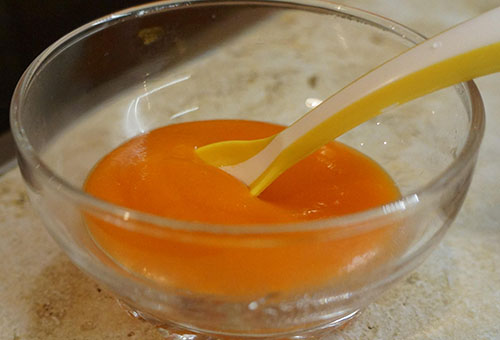
Potato and carrot puree in the diet of a newborn
About half a month after the child is used to apples, zucchini or cauliflower (but not earlier than 3.5 months), you can try to introduce mashed potatoes. The product will be slightly different from the usual adult dish.
Particular attention should be paid to the preparation of the main ingredient.
- Vegetables should be fresh, without nitrates (preferably from the garden).
- For cooking, do not use fruits with sprouts, signs of greenery or rotting under the skin.
- For baby food you must first remove a thick layer of peel from the vegetable and soak the peeled tuber for a day in cold water. Do not give children a freshly purified product, it contains too much starch.
The best option for babies is mashed potatoes with herbs. The prepared root crop is cut into cubes, placed in a saucepan with boiling water and boiled for at least 10 minutes over low heat. When the product is almost ready, three tablespoons of finely chopped cabbage or greens are added to the pan. Vegetables are boiled to completely soften the ingredients. After that, the water must be drained, and the thick part must be passed through a sieve or chopped with a blender. For taste and a pleasant texture, you can add a tablespoon of milk. Salting potato food is not recommended!
Over time, you can start adding carrot puree to the dish, this will not only have a good effect on the taste of the product, but also provide the children's body with useful vitamins and nutrients.

Rules for the introduction of vegetable puree
Pediatricians say that vegetable nutrition is the best option for complementary foods, it is very rare for children to develop allergies or adverse reactions in the form of indigestion. You can enter the first dishes as early as 3.5-4 months. You need to start with single-component formulations, gradually combining them with each other and accustoming the newborn to complex dishes.
There are types vegetable puree, which can be offered to babies from 1-2 months old, without reducing the proportion of breastfeeding.
- Carrot baby food. To prepare the dish, carrots, milk, a little butter and saline are used. The root crop is first boiled until fully cooked and rubbed on a fine grater. Butter is added to the mass at the tip of a knife and a little brine(a teaspoon of salt diluted in a glass of water). Everything is passed through a sieve and given to the child.
- Liquid cauliflower paste. Cauliflower inflorescences are first scalded with boiling water, then washed and placed in hot water. Vegetables are lightly salted and boiled until tender. Then the water is drained, the boiled inflorescences are poured with milk and crushed with a blender to a state of very liquid porridge. You can add a few drops of unrefined vegetable oil to the finished vegetable food.
When the child gets used to one ingredient, a new vegetable dish is introduced. A newborn should have a varied diet, so you should not get hung up on one component and give it all the time, even if his baby loves more than others.
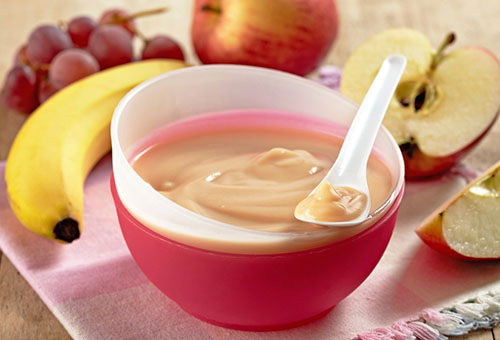
Rules for preparing fruit puree for a newborn
One-component fruit puree is recommended to be introduced into the diet no earlier than three months, and it can be offered to a breastfed baby with a stable weight gain even at six months. The main rule for fruit dishes is that they should not be given as a main dish, only as a vitamin dessert. An exception is carrot nutrition with the addition of a small amount of fruit pulp.
Fruit baby food can be purchased ready-made, but natural products are always better absorbed.
Self-preparation of fruit puree is based on the following rules.
- Fruits should not just be washed, it is recommended to pour boiling water over them.
- The peel is always peeled off, even from the softest fruits.
- It is better to grind the pulp through a sieve, do not abuse the blender (the mass structure with two types of processing is noticeably different).
- You need to start with light green (yellowish) apples or pears. The taste of the fruit should be sweet and sour. Do not give your child sugar from the very first months of life. So you can provoke the development of addiction, which in the future will negatively affect the state of health.

Prune puree: characteristics and features of the introduction of complementary foods
At six months, the baby's diet is recommended to be replenished with prunes. A huge amount of vitamins and nutritional components will have a beneficial effect on the children's body, and even the most capricious baby will appreciate the taste of dried fruit. No less important is the fact that prunes contain substances that have a slight laxative effect on the intestines.
Steps for preparing prune puree
- Berries should be washed, scalded with boiling water, rinsed again and poured with boiled water. The product must stand overnight.
- The next day, the prunes are taken out of the water (liquid is still needed) and rubbed through a sieve. If necessary, you can carefully remove the skin.
- In the resulting thick mass, you can pour a little water drained from the berries and mix well. Salt and sugar are not added.
When the child grows up a little, the recipe is recommended to be slightly modified. Prunes are not soaked, but boiled, whipped with a blender, a little sugar is added and boiled again. A few minutes before turning off the stove, add a little starch, it will give the dish a pleasant texture.
The correct and responsible approach to the introduction of new products will significantly reduce the risk of developing digestive disorders in a newborn. The gradual addiction of the body will protect the child from allergic reactions, beriberi and dyspeptic syndrome.
